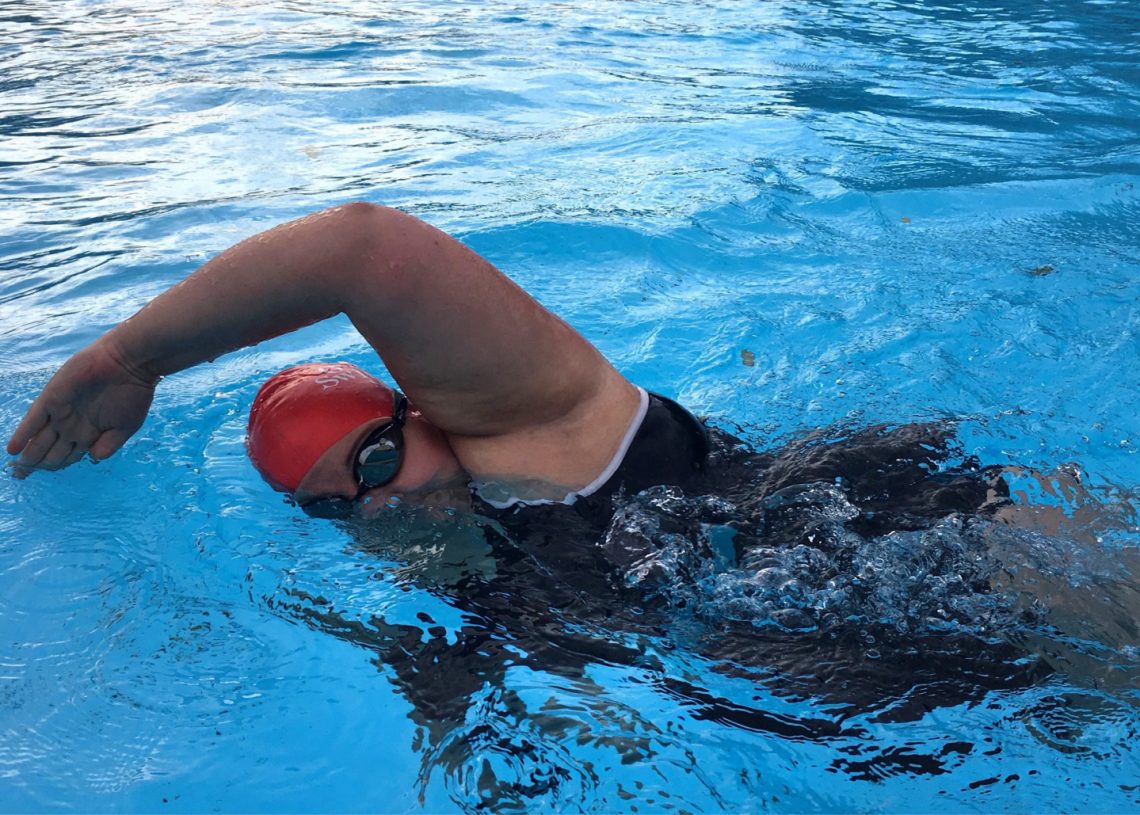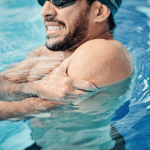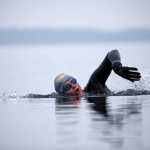
Returning to long-distance swimming after a break
After a period of time swimming simply for pleasure, Editor Ella Foote has decided it’s time to take on some more challenging swims. Here, she asks swimming coach Cassie Patten to share tips for how to return to long-distance swimming after a break.
In 2023, I would like to return to long-distance swimming. I used to do at least one longer swim event a year, but in 2016 after 10 years of events each summer, I decided to stop training and just swim for swimming pleasure and joy. I have had a fantastic time!
Over the years, due to bad technique, I really messed up my shoulder and I also seem to get terrible calf cramps after about 2K of swimming. I want to do a long-distance swim in 2023, possibly a 10K and another 6-7K. But I have no idea how to start preparing for that.
Even when I was swimming a lot, I had no idea what I was doing. I have never been in a club or done any structured training with a masters team. While I am a coach myself, I can’t seem to figure out how to work on myself. I used to swim three times a week in a pool, swimming for an hour each time, and then did some longer swims in open water. I just swam at a comfortable pace and got some distance in the arms.
My other challenge is I have gained a lot of weight in the last six years and my fitness is poor. I am willing to take steps to address this, but I have no idea where this leaves me with swimming.
I am not completely at a loss. As a swim guide, teacher and coach as well as my work at the magazine I am in water a lot. I can do 3K without much effort, just not fast or pretty.
A lot of the training I have done in the past has been punishing and miserable, I want preparing and training to be more positive. Any advice where I can start?
Ella Foote, Outdoor Swimmer Editor
Swimming coach Cassie Patten answers
Thank you for your question and for being so honest. I would love to help you and reading your question makes me so happy as you have a positive mindset around wanting to get back to something you have enjoyed in the past. Your question has many elements so let’s unpick them one at a time.
Firstly, you mentioned your technique has had a negative impact on your shoulder. As someone whose swimming career was cut short due to a shoulder injury, I can empathise with this. As a coach I am sure you are aware of the impact incorrect technique can have on your swimming. For example, entering the water thumb-first can put pressure on your biceps tendon which can lead to tendonitis, or in my case permanent damage to the tendon.
Another common error that can injure shoulders is the hands entering too close to your centreline, and not in the correct 11–1 position where your hands enter directly in line with your shoulders. These two very common incorrect technique points teamed with incorrect rotation can lead to serious shoulder injuries.
Swimming is frustrating, as you have no visual guidance on what your technique is doing, unless it is being videoed. I would recommend either seeing a technique coach or, as you are a coach yourself, videoing your technique and analysing it yourself. I recently did this on my YouTube channel and it was amazing what I picked up on with my own swimming style.
Training your body’s energy systems
You are not alone in never having swam in a masters club, most adult swimmers I know haven’t got a swimming club background either. I always recommend setting an expectation for the swim you are about to do, which could be to simply enjoy the water or to have a training goal in mind.
When training for fitness it is important to remember you are training your body’s energy systems as a whole. Most people get into the water and simply swim, but this keeps the heart rate low and is only training the low-level aerobic system. This is what allows you to swim your 3K without much effort; however, if you were to try and swim faster or longer, it would be difficult.
I write remote programmes for competitive sprint swimmers to people who are training for a 10K, and I ensure that we cover all areas within their training sessions. Examples of the different types of sessions I include are high aerobic capacity sessions, otherwise known as a ‘heart rate set’. In these sessions I ask my swimmer to perform repetitions of either 50 or 100 metres at 80% of max effort. It should be hard work!
A top tip is to try to maintain the best average time not to start out max and then rapidly drop down in pace. I also include sprint sets, where you are swimming at 80-90% of your max. These sessions are short in distance but high in intensity. As a distance swimmer these sprint sessions should only be inserted in your training regime once or twice a month. These varied sessions should punctate your lower intensity training.
When swimming at lower intensity, work on technique as this not only gives you a focus but will ultimately increase efficiency. As you build your training volume up to the bigger events it does not have to become tedious. Try and mix up your sessions by including elements such as: pulling with a pull-buoy; kicking with fins; drills; stroke counting and trying to reduce it every 50m.
Swimming is a great sport for many reasons. As it is not weight-bearing it doesn’t put stress on your joints like running does, but losing weight can be difficult to do through swimming. As a professional swimmer I was always being told I needed to lose weight but no matter what I tried I could not do it through swimming alone. I find walking is a great way to build land fitness as well as helping burn fat. I have incorporated this into my routine, and I feel good for it.
I also lift weights – now this is not as scary as it sounds! I started at home with some second-hand weights I bought online. Lifting weights is a fantastic way to tone up and build upper body strength to help with your swimming. I have put together three simple swimming gym exercises that are completely ‘swim specific’ so will really help building strength in the correct muscles for the catchphrase. You can find them on my YouTube channel by searching ‘Cassandra Patten, head coach at WaveCrest swimming’.
I really hope this helps you start on the path you want to travel this year. If you want more information and to see a couple of complete sessions have a look at wavecrestswimming.com where there is a whole section dedicated to putting together a training session. I look forward to seeing what swim adventures you have this year.
This article is from the January 2023 issue of Outdoor Swimmer. Click here to subscribe to the magazine.









